-
TrackoBit
Manage commercial vehicles with the new-age Fleet Management Software
TrackoBit -
TrackoField
Streamline your scattered workforce with Field Force Management Software
TrackoField -
Features Resources
-
Blog
Carefully curated articles to update you on industrial trends. -
White Paper
Insightful papers and analysis on essential subject matters. -
Glossary
Explore an alphabetical list of relevant industry terms. -
What’s New
Get TrackoBit & TrackoField monthly updates here. -
Case Study
Explore the cases we solved with our diverse solutions. -
Comparisons
Compare platforms, features, and pricing to find your best fit.
-
About Us
Get to know TrackoBit: our team, ethos, values, and vision. -
Careers
Join the most dynamic cult of coders, creatives and changemakers. -
Tech Support
Learn about our technical support team and services in detail. -
Events
Check out the exhibitions where we left our marks and conquered. -
Contact Us
Connect with us and let us know how we can be of service.
What is Parcel Shipping and Delivery?
- Author:Tithi Agarwal
- Read Time:9 min
- Published:
- Last Update: January 7, 2026
Table of Contents
Toggle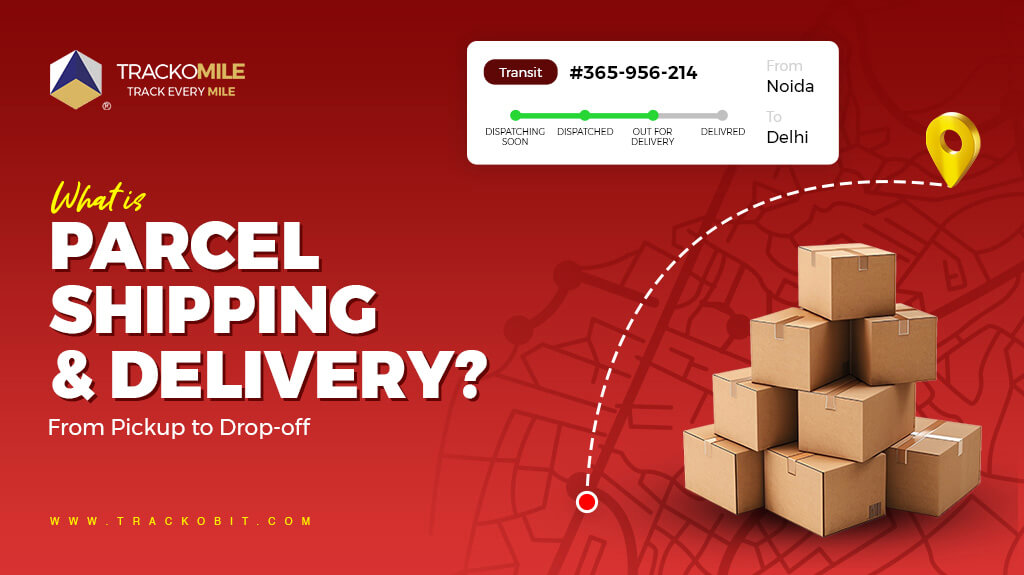
A lot goes into making parcel shipping and delivery as smooth as possible.
Table of Contents
Toggle
59 million parcels are shipped daily in the United States alone, with numerous carrier services handling a wide range of parcel sizes from small 100g parcels to massive 45,000 lbs shipments.
Parcel shipping is not easy. It requires courier service providers to follow multiple steps before a parcel is delivered to customers. From packing to quality inspection to selecting the right mode of shipment, be it FTL or LTL, dispatchers are on their toes. That is why brands or businesses need to ensure they choose parcel shipping service providers that can guarantee safe and on-time parcel delivery.
By reading this article, you will know the process and factors to consider when choosing courier or delivery service providers. This will ensure that you stay aware of the process while proceeding.
What is Parcel Shipping?
Parcel shipping refers to couriers and postal companies transporting boxed objects. These parcels are usually boxed items that individuals or businesses send through various freight carriers that can handle different sizes, weights, and destination locations.
Parcel delivery occurs after the shipped parcels reach the distribution center. It is a key component of modern commerce, connecting customers and companies globally. It also plays an important role in the supply chain, ensuring timely and secure transportation of commodities from sellers to buyers. This complex process includes various stages, which we will discuss later.
Types of Parcels
Many different kinds of parcels can be delivered using parcel delivery, and each one requires special care and handling. These can be classified as:
- Small parcels are compact and lightweight things such as gadgets or accessories.
- Large parcels include bulkier objects like appliances or furniture.
- Fragile parcels are delicate items that require careful packaging, like glassware or electronics.
- Perishable parcels, such as fresh vegetables or flowers, have a shorter shelf life.
Hence, it is important to be aware of the type of parcel to choose the best delivery option, guaranteeing safe delivery from the sender to the receiver.
Key Differences Between Parcel and LTL Shipping
While both have inherent advantages and drawbacks, the decision to choose between parcel shipping or LTL is not always clear. The table below can help you quickly evaluate the differences in shipping methods.
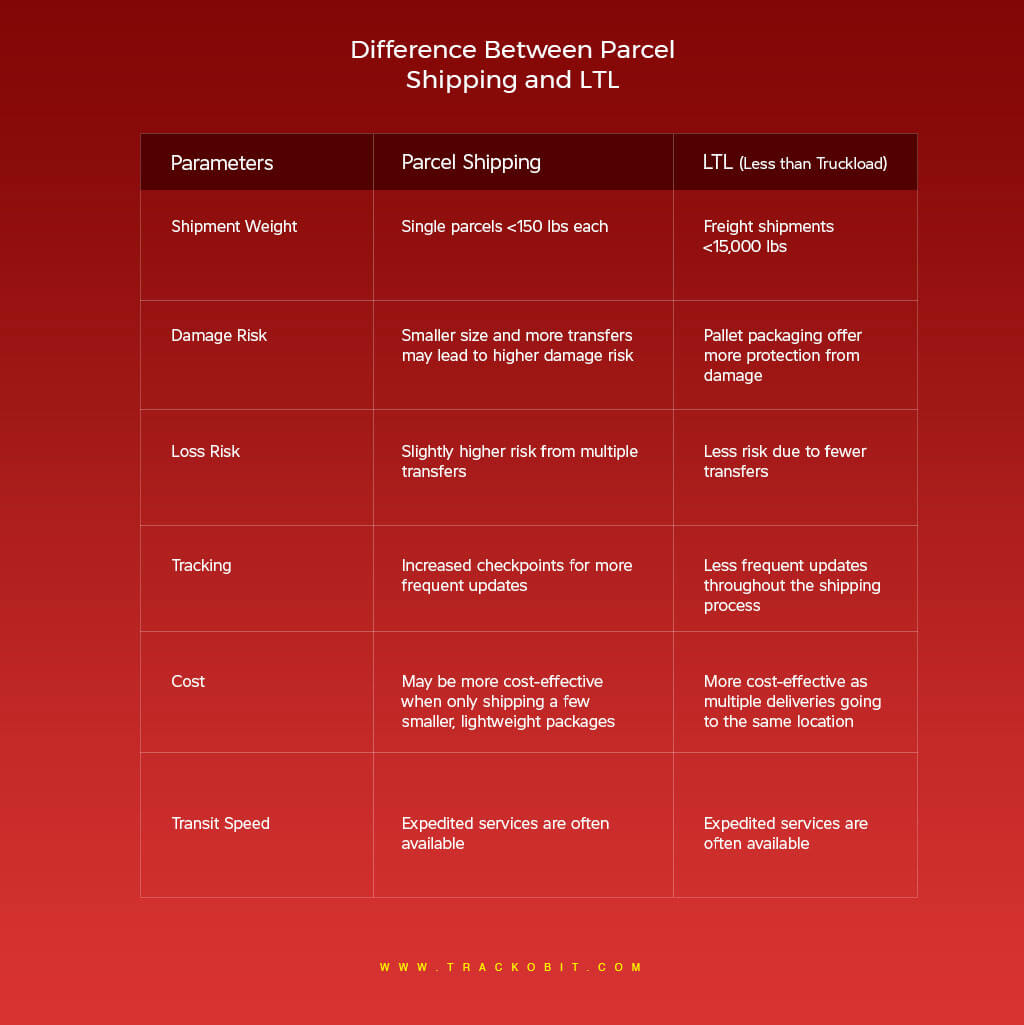
How Does Parcel Shipping Work?
Here are the stages of parcel shipping and delivery.
1. Packaging
The initial step in delivering a parcel is packaging, which guards against anything getting damaged on the way. The type of packaging used for an item will depend on its characteristics, such as its delicate nature. Perishable goods require cool packs with insulated packaging, while breakable materials require foams and bubble wrap. Large items may also require sturdy crates or reinforced boxes for their consignment.
Effective packing aims to minimise movement inside a package, cushion shock, and protect it from outside factors like moisture or temperature changes. Employing environmentally friendly packing materials may also satisfy several eco-standards and legal criteria.
2. Labeling
This is essential to guarantee that packages are tracked down and shipped efficiently. Most contemporary parcel labels contain essential information like package weight, sender and destination addresses, and machine-readable barcodes or QR codes that a shipper’s tracking system can scan.
Throughout the process, the barcode is scanned multiple times, and updates on a specific consignment are then displayed in a central database. Labels should be readable from the point of shipment to the point of delivery, and they should also emphasize visibility and the longevity of the glue used to adhere them.
3. Collection
The collection includes the first retrieval of parcels from sellers and businesses via prearranged pickups from warehouses or designated drop-off locations. Most businesses that provide parcel services set themselves up to provide frequent pickups.
Efficient collecting procedures are crucial for increasing volumes during peak mailing seasons, particularly Christmas time, and guaranteeing punctuality until the delivery window opens. Furthermore, preliminary sorting may also be part of this stage to speed up processing at distribution centers.
4. Sorting
Collected parcels are processed in highly automated sorting facilities before being distributed. At the sorting centres, packages are sorted by size, weight, destination, and urgency using both automated equipment and human labour.
Packages are directed to specified bins or pallets meant for various delivery routes or types of transportation via automated conveyors, scanners, and sorting devices. This process is essential to effective logistics because it reduces bottlenecks and improves the flow of commodities in supply chains.
5. Transport
Depending on the location and speed requirements, parcel transportation encompasses a wide range of operations using trucks, railroads, airplanes, and fast ships. Road transportation is the most effective mode of transportation for local deliveries, but cargo planes may be needed to ensure quick travel times for long-distance or cross-border products.
The optimal kind of transportation is chosen based on a number of considerations, including speed, economy, and whether or not perishables need to be kept at a certain temperature while being shipped. In addition, smooth transitions between different carriers and modes are ensured to prevent scheduling delays.
6. Delivery
The “last-mile” delivery, the final leg of the cargo procedure, appears to be difficult and costly. During this stage, customers can choose when they would like their items delivered, schedule delivery, and receive confirmation that the items were delivered, among other options.
Thanks to internet-based methods such as GPS monitoring and smartphone applications, customers can now trace their packages in real time until delivery with instant notifications. Secure procedures like requesting signatures or offering secure locations for them to be dropped off are also helpful to ensure their safe receipt.
These steps highlight the intricacy of parcel shipping and illuminate how crucial it is for each stage to be done right to have efficient, safe, and customer-friendly delivery services.
Top 10 Benefits of Parcel Shipping
Parcel shipping offers several advantages.
- Convenience: Parcel shipping services usually offer door-to-door delivery. This means businesses can have courier companies pick packages from their warehouses and deliver them straight to the customers. This eliminates the need to drop off or collect packages from a depot or warehouse.
- Flexibility: Parcel shipping services offer various options to cater to different needs. Businesses can choose between ground, air, or sea shipping, express or economy delivery, and even add extra services such as insurance or signature on delivery.
- Trackability: Most parcel shipping services provide tracking numbers for shipments. This allows both senders and recipients to monitor the progress of the delivery, providing visibility and peace of mind. Last-mile delivery software makes sharing ETA easy and enhances the visibility of the shipping and delivery process.
![]()
- Cost-effective: Parcel shipping is typically more affordable for small packages, especially for domestic deliveries. Prices are usually based on the weight and size of the parcel and the distance it needs to travel. You can also reduce fuel costs by shipping parcels LTL.
- Speed: Depending on the service level chosen, parcel shipping can be quite fast. Same-day, overnight, and express options are often available.
- Customer satisfaction: Reliable and timely delivery of goods directly affects customer satisfaction. With parcel shipping, businesses can ensure their products reach customers safely and in a timely manner, contributing to positive customer experiences.
Challenges of Parcel Shipping
Despite its many advantages, parcel shipping has challenges.
- Risk of damage or Loss: Packages may be lost or damaged throughout the parcel shipment process, particularly if they are not handled or packed carefully. This risk can be reduced by selecting reputable shipping companies, purchasing insurance, and using suitable packaging.
- Customs regulations: Following custom laws when shipping packages internationally can be difficult. Every nation has its own laws governing imports and exports, which, if not appropriately addressed, can cause delays or extra expenses.
- Delivery delays: Despite estimated delivery times, unforeseen issues like weather conditions, technical glitches, or customs delays can cause parcels to arrive later than expected.
- Cost: While parcel shipping is generally cost-effective for smaller items, it can become expensive for heavier or larger items, particularly for long-distance or international shipping.
- Limited size and weight: Package weight and dimensions are typically limited when sending parcels. Any amount over these would normally need to be transported via goods, which can be more expensive and complicated.
- Tracking accuracy: While most parcel services offer tracking, the accuracy and real-time updates can sometimes be lacking. This can lead to uncertainty about a parcel’s exact location or delivery time. (The easy solution to this challenge would be to use a last mile delivery software, which tracks parcels in real time and reduces chances of loss in transit)
- Return and redelivery hassles: If the customer is not available to receive the delivery, it can result in the need for redelivery or return, which can be inconvenient and time-consuming.
Read Blog – Best Courier Delivery Software of 2026
Factors To Consider In Parcel Delivery Services
To ensure a seamless experience, choosing the best parcel delivery service requires carefully evaluating several factors. Some of them are:
1. Speed Of Delivery
The speed of delivery your customers choose reflects the urgency of the shipment. The parcel delivery services offer options, from same-day delivery to next-day delivery and ordinary delivery options for flexibility.
2. Cost of Delivery
It’s crucial to compare the pricing structures of various delivery providers regarding shipping costs. When pricing and service levels are balanced, finding the best value for your money is easier.
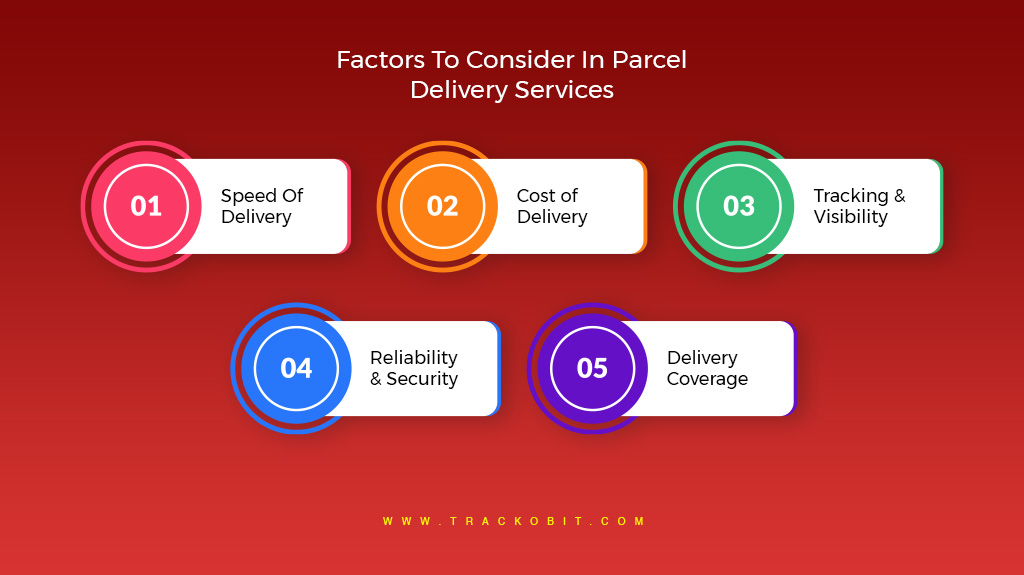
3. Tracking And Visibility
Customers can feel secure with the feature of real-time tracking. Senders and recipients may reliably trace the progress of their packages with sophisticated tracking capabilities offered by courier services through last mile delivery software.
4. Reliability And Security
A reputable service guarantees that packages arrive on schedule and in perfect shape. Strong security procedures guard against loss, theft, or damage in transit.
5. Delivery Coverage
The geographical scope is crucial. Examining a delivery service’s coverage area will help you ensure that your packages arrive at their destinations, whether near or thousands of miles away.
Thus, evaluating these factors can help you choose the parcel delivery service that best suits your unique requirements and ensures prompt, secure, and hassle-free delivery.
Key Considerations For Choosing The Best Last Mile Delivery Software
When choosing the best last mile delivery software to make parcel delivery more efficient and optimal, consider these features:
- Dynamic dispatcher solution for automatic pairing of orders with riders and carriers. It considers the priority of the order, the same-day or next-day delivery window chosen by the customers, and more.
- Route optimization solution that uses advanced algorithms and analytics to suggest the shortest and most efficient route for delivery. It does so after considering 120+ factors. These factors are traffic conditions, driver availability, delivery time window.
- Riser roster feature that provides a comprehensive view of the available drivers and vehicles and their shift schedules. This makes scheduling riders even easier.
- The rider app for delegating delivery jobs, tasks, schedules, orders, optimal routes, customer info, and important instructions to riders. It should include a chatbox for easy communication with managers, a feature to mark attendance, and the ability to collect POD.
- Real-time tracking is vital for full visibility of the dispatch process on a centralized dashboard, showing orders in progress, available riders, ETAs, and delivery vehicles. This helps anticipate and resolve issues. ETAs sharing with consumers to reduce missed deliveries.
- Detailed and comprehensive reports to get real-time insights into the on-ground analytics in seconds. These reports provide an accurate idea of
- Number of deliveries completed by riders
- Missed deliveries or stops
- Rider performance in terms of maximum on-time and safe deliveries
- The overall cost of parcel delivery
Streamline Shipment Delivery with TrackoMile’s Last Mile Delivery Software
Parcel shipping is an indispensable service that supports both domestic and international trade. With advantages like affordability, ease of use, and adaptability, it’s a great option for both individuals and companies. Even if the shipping process has its challenges, knowing how to deal with them timely will guarantee a good shipping experience.
The parcel process is not just about getting a package from point A to point B. It concerns the whole trip: the way the package is handled, the speed at which it is delivered, and most importantly, the happiness of your clients. Make an informed decision by taking the time to comprehend your parcel shipping options.
TrackoMile’s last-mile delivery software helps delivery service providers deliver parcels on time and at optimal costs. It has all the required features and more that will optimize the delivery operation and reduce the chances of parcels getting lost or needing second-attempt delivery.
Tithi Agarwal is an established content marketing specialist with years of experience in Telematics and the SaaS domain. With a strong background in literature and industrial expertise in technical wr... Read More
Related Blogs
-
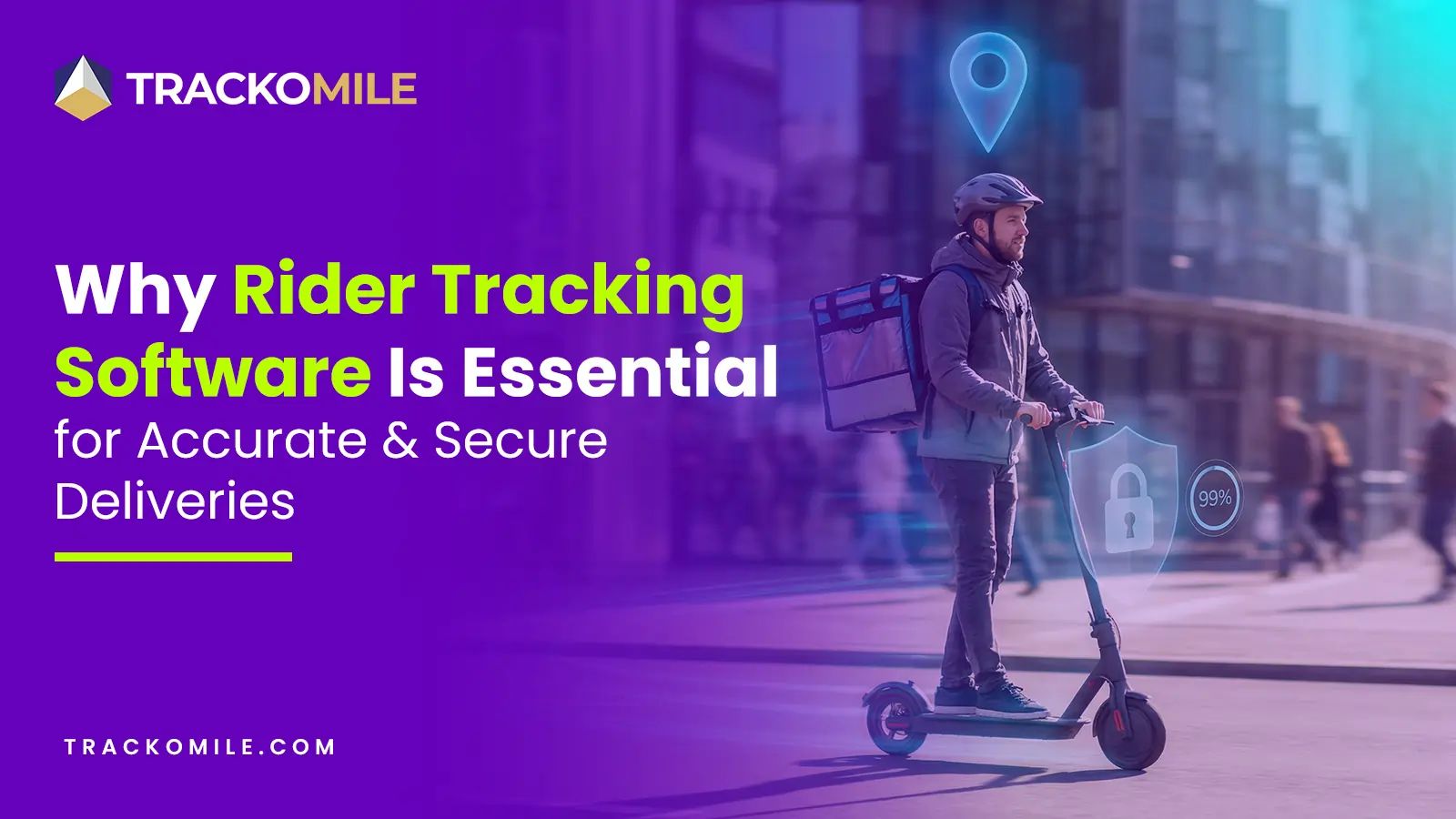
How Rider Tracking Software Improves Delivery Accuracy and Reduces Fraud
Tithi Agarwal December 8, 2025Rider tracking software improves delivery accuracy with real-time GPS visibility and automated ePOD. It also enables route optimisation and fraud…
-
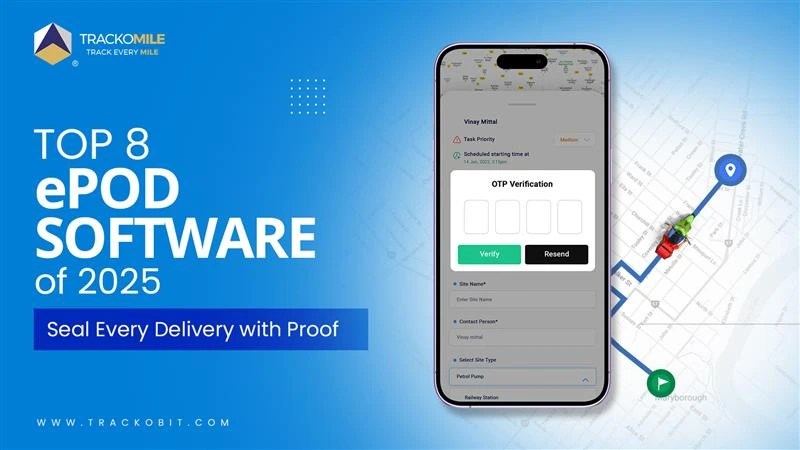
Top Electronic Proof of Delivery (ePOD) Software in 2026
Tithi Agarwal September 25, 2025Electronic proof of delivery has become the backbone of modern logistics. Explore the top 8 ePOD software in 2026 and…
-
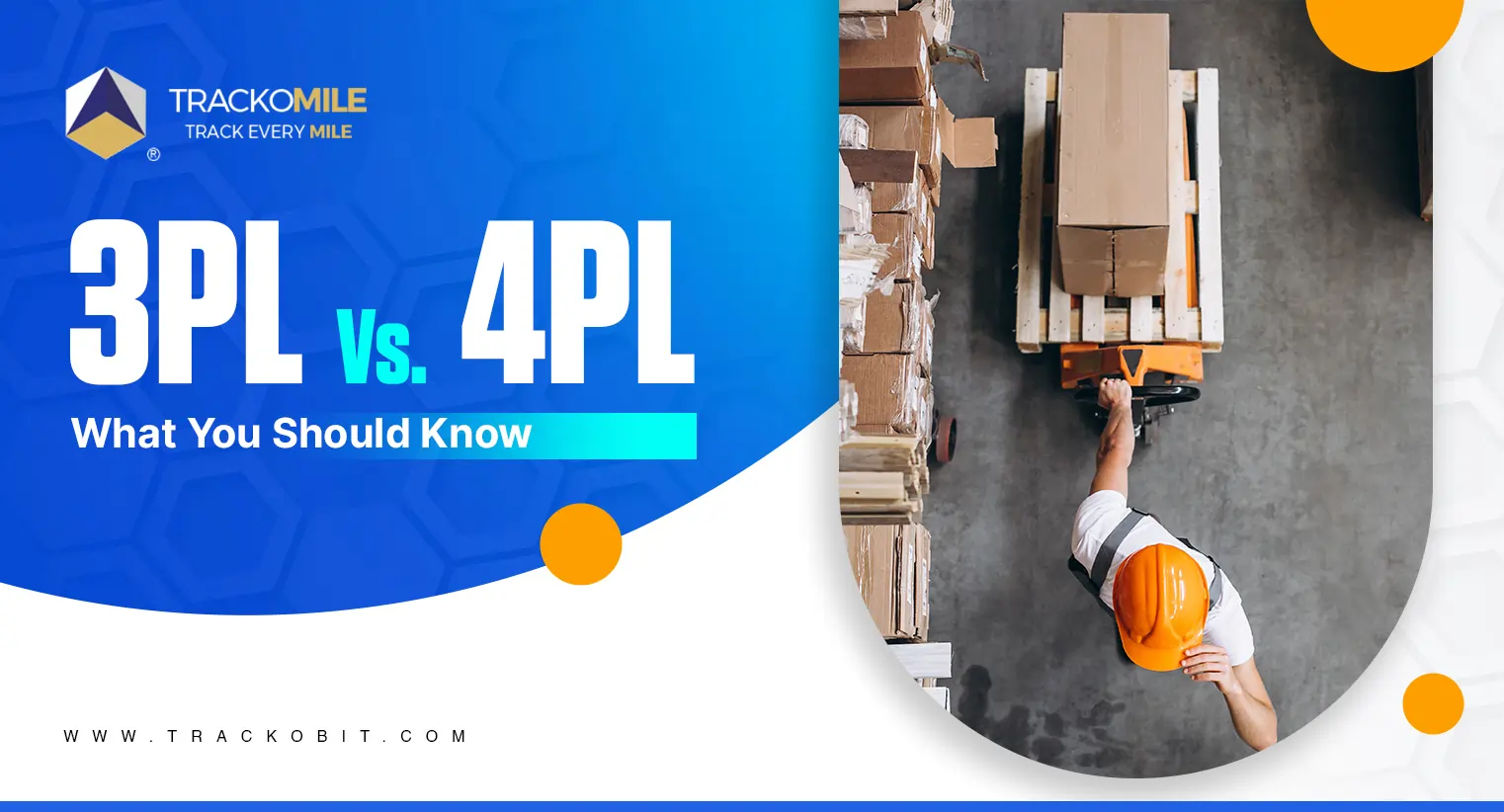
3PL vs. 4PL: Which is Best for Your Business?
Tithi Agarwal September 25, 2024Confused about choosing between 3PL and 4PL for your retail supply chain? Read this blog to find out which is…
-
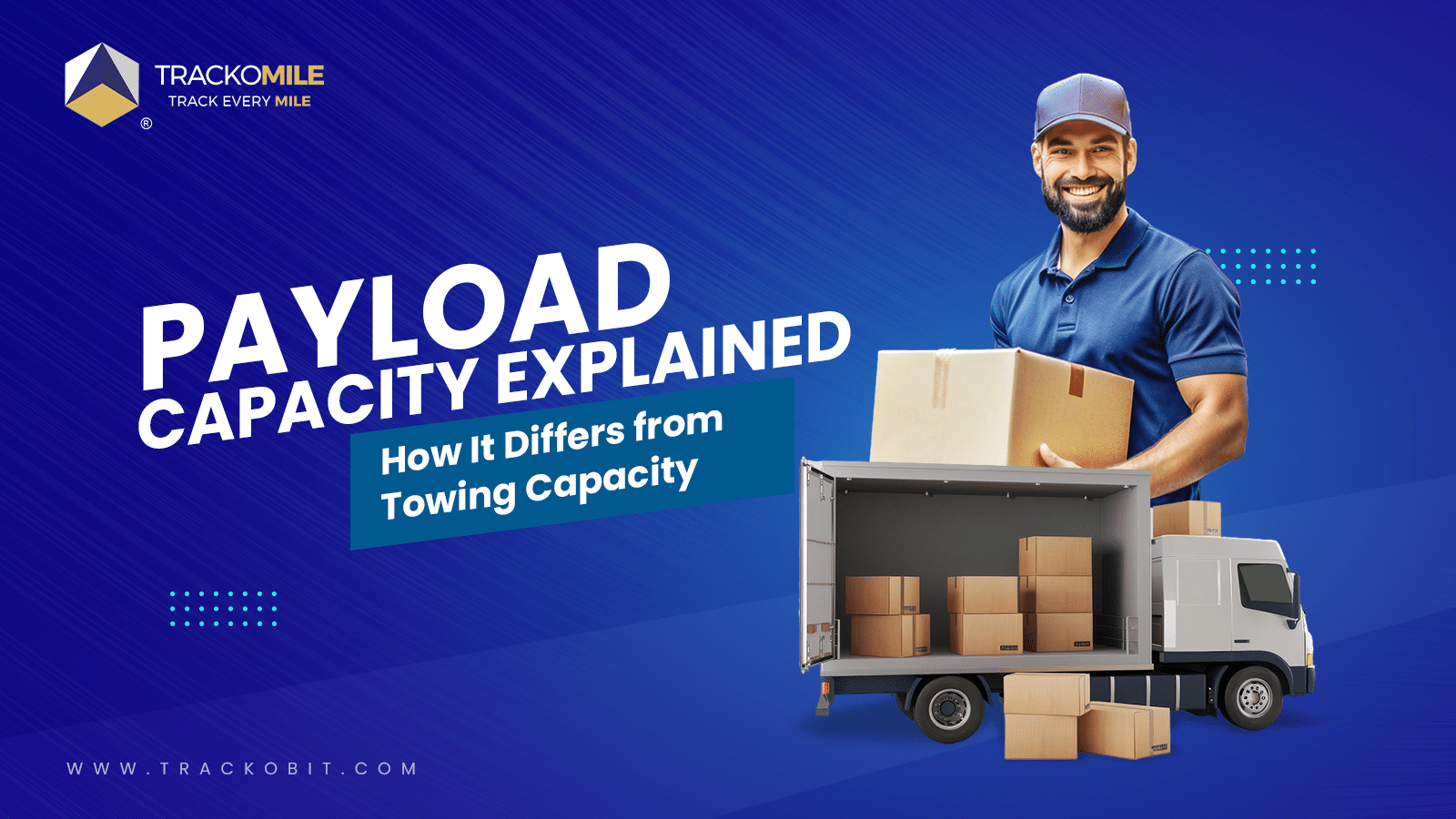
What is Payload Capacity? Payload Capacity Vs. Towing Capacity
Tithi Agarwal September 10, 2024Payload capacity is the total weight a vehicle can safely carry, and it is crucial for safety and compliance. Exceeding…

Subscribe for weekly tips to supercharge your last-mile delivery.
Your inbox awaits a welcome email. Stay tuned for the latest blog updates & expert insights.
"While you're here, dive into some more reads or grab quick bites from our social platforms!"Stay Updated on tech, telematics and mobility. Don't miss out on the latest in the industry.
We use cookies to enhance and personalize your browsing experience. By continuing to use our website, you agree to our Privacy Policy.


































